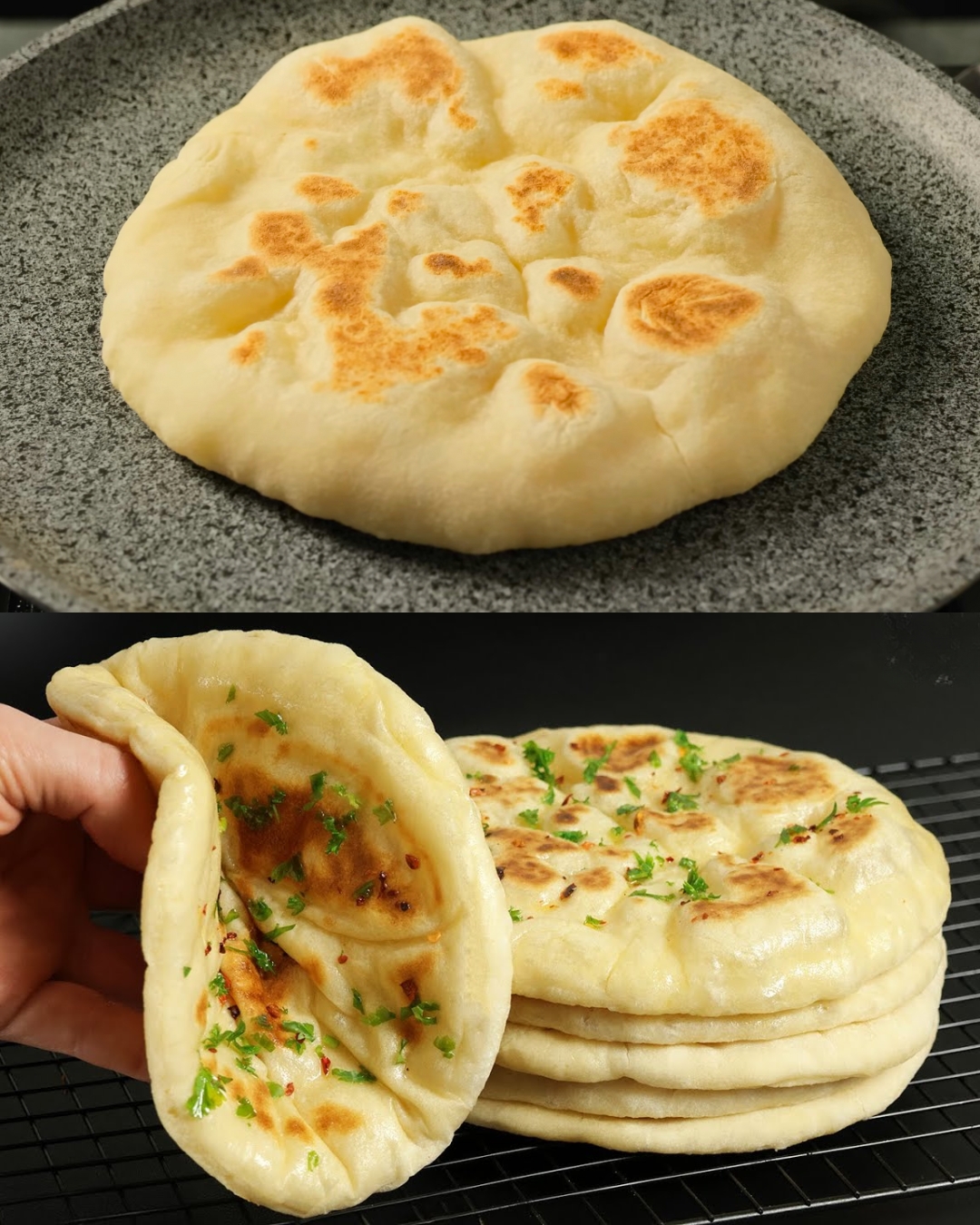ADVERTISEMENT
In a mixing bowl, combine 2 teaspoons of dry yeast, 2 teaspoons of sugar, and 2/3 cup of warm water.
Add 2/3 cup of warm milk to the bowl and stir to dissolve the yeast.
Cover the bowl and let it sit for 10 minutes until the mixture becomes frothy.
Prepare the Dough:
In a large mixing bowl, sift 500 grams of flour and add 1 teaspoon of salt.
Pour the yeast mixture into the flour and mix with a spoon until a dough starts to form.
Add 1 tablespoon of olive oil and knead the dough by hand for about 2 minutes. The dough should be very soft and slightly sticky.
Let the Dough Rise:
Cover the dough with a clean cloth and place it in a warm area to rise for 1 hour, or until it has doubled in size.
Shape the Flatbreads:
Once the dough has risen, sprinkle a clean surface with flour and gently press the air out of the dough.
Divide the dough into 6 equal parts and shape each part into a ball.
Cover the dough balls to prevent them from drying out while you work.
Using a rolling pin, roll each dough ball into a circle with a diameter of about 18 centimeters (7 inches) and a thickness of about 5 millimeters.
Cook the Flatbreads:
Heat a dry pan over medium heat.
Place one of the rolled-out dough circles in the hot pan.
Cook for about 3 minutes, or until bubbles start to appear on the surface. Flip the bread and cook the other side until golden brown.
Repeat this process with the remaining dough, rolling out the next piece while one is cooking.
Finish and Serve:
Once each flatbread is cooked, immediately cover it with a tea towel to keep it soft.
Finely chop some fresh parsley.
Brush each warm flatbread with olive oil and sprinkle with chopped parsley and red pepper to taste.
Serving Suggestions:
This Turkish flatbread is perfect for slopping up your favorite curries, dips, or enjoying plain, straight out of the skillet.
Tips:
Rolling the Dough: For convenience, use a silicone cooking mat when rolling out the dough.
Cooking Speed: All actions are very fast; while one bread is frying, roll out the next one to keep the process smooth.
Keeping Flatbread Soft: Cover hot flatbreads with a tea towel immediately after cooking to keep them soft and pliable.
Frequently Asked Questions (FAQs)
Can I use instant yeast instead of dry yeast?
Yes, you can use instant yeast in place of dry yeast. You don’t need to activate instant yeast in water; simply add it directly to the flour along with the other dry ingredients. However, if you do want to activate it, follow the same instructions as for dry yeast.
Can I make the dough ahead of time?
Yes, you can prepare the dough in advance. After kneading, cover the dough and refrigerate it for up to 24 hours. When you’re ready to cook, allow the dough to come to room temperature and continue with the rolling and cooking steps.
What if I don’t have a silicone cooking mat?
If you don’t have a silicone cooking mat, you can use a lightly floured countertop or any clean, flat surface for rolling out the dough.
Can I bake these flatbreads in the oven instead of cooking them in a pan?
These flatbreads are traditionally cooked in a hot pan, but you can bake them if you prefer. Preheat your oven to 475°F (245°C) and bake the flatbreads on a preheated baking stone or a baking sheet for 5-7 minutes, or until they puff up and turn golden brown.
How do I store leftover flatbreads?
Store any leftover flatbreads in an airtight container or wrap them in aluminum foil. They can be kept at room temperature for up to 2 days or refrigerated for up to 5 days. Reheat them in a pan or oven before serving.
Can I freeze the dough or the cooked flatbreads?
Yes, both the dough and the cooked flatbreads can be frozen. For the dough, divide it into portions, wrap tightly in plastic wrap, and freeze for up to 3 months. Thaw in the refrigerator overnight before using. For cooked flatbreads, wrap them in plastic wrap and freeze in a ziplock bag for up to 3 months. Reheat directly from frozen in a pan or oven.
Can I use whole wheat flour instead of all-purpose flour?
Yes, you can substitute whole wheat flour for all or part of the all-purpose flour. However, whole wheat flour will make the flatbreads denser and may require a bit more water or milk to achieve the desired dough consistency.
Why is my dough too sticky or too dry?
If your dough is too sticky, add a little more flour, a tablespoon at a time, until it becomes manageable. If it’s too dry, add a bit more water or milk, a tablespoon at a time, until it reaches the right consistency.
How can I make the flatbreads more flavorful?
You can add herbs like rosemary, thyme, or oregano to the dough for extra flavor. You can also mix garlic or onion powder into the dough, or sprinkle them on top after brushing with olive oil.
Can I make these flatbreads without milk?
Yes, you can substitute the milk with water or a plant-based milk alternative, such as almond or soy milk, for a dairy-free version. The texture may be slightly different, but they will still be delicious.
Enjoy this fluffy, bubbly, and chewy Turkish Flatbread that’s just like the one you get at Turkish restaurants!
For Complete Cooking STEPS Please Head On Over To Next Page Or Open button (>) and don’t forget to SHARE with your Facebook friends ADVERTISEMENT
ADVERTISEMENT
